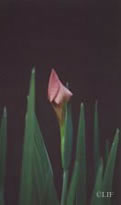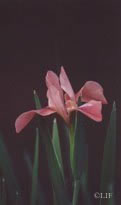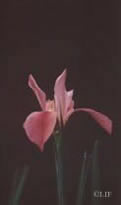Louisiana Irises in the Land of Lincoln
|
|
|
|
Louisiana Irises in the Land of Lincoln
Kansas is located about 30 miles (48 km.) west of Terre Haute, Indiana in plant hardiness zone 6. Typical winter temperatures reach as low as -20t FACE="Symbol">°F (-29°C) with maximum summer temperatures in the range of 100°F (38°C). Humidity is high in summer, but droughts are not infrequent. Annual rainfall is 36-40 inches (90-100 cm.), much of which occurs during the spring and fall. Soils are slightly acid and it may not be necessary to make an acid bed. The growing season for Louisiana irises approaches 8 months.
While preparation of an acid bed is not strictly necessary, the irises respond well to a fertile and well conditioned soil with added acidic components. The beds are located in a low-lying area to aid in water retention. Rotted steer or horse manure, or peat moss are excellent soil conditioners. Complete commercial fertilizers such as azalea food, 5-10-5 or 10-10-10 are added when the bed is first prepared. If the soil is too loose, bloom stalks may topple and pull the rhizomes out of the ground, particularly when the bloomstalks are heavy with open blooms. Humus can be overdone. Heavy clay soil is excellent if some humus is added. The heavy clay soil does not dry out and hold water well.
New varieties are planted when received, usually in early September. When digging and transplanting in the north, the earlier the better. Good results are obtained by transplanting in late August and early September. Spring planting gives better multiplication but is hard to plant in the spring when the soil is very wet. The irises are planted 30-36 inches (75-90 cm.) apart, and there is little chance they will grow into each other when not transplanted for three years.
In the spring Louisiana irises may be very chlorotic. Severe yellowing of the foliage is a clue to excessive cold, excessive alkalinity or need for fertilizer. If they have not turned green by May, iron sulfate is added, a handful around each plant. Soil sulfur may be sprinkled around each clump. Preferred solid fertilizers include azalea food or commercial fertilizers such as 5-10-5, 10-20-10 or 10-15-10 or whatever acidic or neutral fertilizer is available. "Miracid" is an excellent water soluble fertilizer and foliar food. Solid or liquid fertilizers are usually applied in May and July. Do not use a high nitrogen fertilizer which will give good green foliage but reduced bloom.
The irises are mulched year round with wheat straw. When the ground freezes, usually in late December, more straw is added and "fluffed up" around the plants. Bark chips or pine needles can be used as mulch if available. When the irises are mulched heavily more fertilizer is needed. When the foliage is winter killed it can be trimmed off to make the beds look neater. The foliage can be trimmed in December or early spring. The Louisianas usually stay green until mid-January.
In this area watering is most important during July and August. Irrigation during summer is helpful to most varieties, but a few like FADING BEAUTY, MEDORA WILSON, BUXOM and DENEB have a strong tendency to summer dormancy in spite of apparently sufficient water. This dormancy usually occurs during the summer months of July and August. Some dormant rhizomes may be lost. These plants may require additional mulch and water. Apparently dead rhizomes should not be removed and discarded since they may make lateral growth in cooler weather. Loss of foliage and roots may also be caused by planting too deep, and the rhizome may appear to be dead. The rhizome should be dug, and if sound, planted shallower. Such rhizomes may take 6 months to show lateral growth, so be patient.
Although there is no borer problem a single spraying with "Cygon 2E" is applied to all the irises in April. Slugs are very detrimental to Louisianas and will eat and seriously damage buds and blooms. Slug baits are effective but are poisons and may be a problem with domestic animals. Cutworms can be a very devastating problem with beardless irises. Plants are literally "cut off" at the soil line, usually at night when the worms are active. Two sprayings of "Cygon 2E" did a good job on the cutworms. This is a systemic poison which makes the entire plant poisonous to anything that chews on it. "Dipel" is also effective against cutworms, is not harmful to other animals or people, and can be used on food crops.
It is important to remove stalks and seed pods right after blooming unless seeds are to be planted. Useless pods will sap energy which would otherwise go to producing more divisions. Undesirable "rogue" seedlings also result from bee pods. The most important item is to avoid summer dormancy. Heavy mulching and adequate water will generally curtail summer dormancy. With heavy mulch weeding is not necessary. If the mulch has rotted away it is necessary to hand weed and re-mulch. The mulch tends to rot rapidly in natural "bog" areas because of constant moisture. Some fertilizer should be added before re-mulching in summer.



